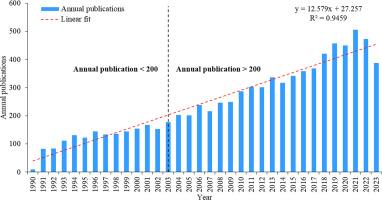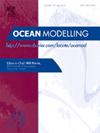Characteristics and trends of ocean turbulent mixing models research in 1990–2023 based on bibliometric analysis
IF 2.9
3区 地球科学
Q2 METEOROLOGY & ATMOSPHERIC SCIENCES
引用次数: 0
Abstract
Ocean turbulent mixing models (OTMMs) have become a popular research topic in recent years, and numerous related research papers have been published. Here, a bibliometric method was utilized to analyze 8411 papers from the Web of Science published from 1990 to 2023 and provide a comprehensive overview based on metrics, including the total publications, countries, institutions, journals, authors, keywords, and subject categories. The results revealed the following. (1) The number of published papers increased gradually, with the USA and China being the main research countries. However, citations per paper in China only accounted for 17.6 %, indicating that there is considerable room for improvement. Seven institutions with a citation per paper rate exceeding 50 % were from the USA, indicating its absolute authority and influence in this field. (2) Astrophysical Journal, Astronomy & Astrophysics, and Geophysical Research Letters were the core journals; Qiao Fangli, Xue Ming, and Madec Gurvan were the most representative authors; Model, turbulence, and circulation were the most frequent keywords; and Oceanography, Meteorology Atmospheric Sciences, and Environmental Sciences were the most important subject categories over the past 30 years. (3) OTMMs have evolved from simplified models to ultra-high degree-of-freedom numerical models with a faster operation speed, higher spatiotemporal resolution and more complete physical processes. Therefore, decreasing the bias of OTMMs in simulating the upper ocean is an international scientific frontier and long-term technical challenge for ocean and climate prediction. This is the first comprehensive visualization and analysis of this research hotspot and its trends.

基于文献计量分析的1990-2023年海洋湍流混合模式研究特征与趋势
近年来,海洋湍流混合模型(otmm)成为一个热门的研究课题,并发表了大量相关的研究论文。本文采用文献计量学方法,对Web of Science 1990 ~ 2023年间发表的8411篇论文进行了分析,并基于出版物总量、国家、机构、期刊、作者、关键词和主题类别等指标进行了综合分析。结果显示如下。(1)论文发表数量逐渐增加,以美国和中国为主要研究国。然而,中国的论文被引率仅占17.6%,这表明还有很大的提升空间。7家论文被引率超过50%的机构来自美国,显示出美国在该领域的绝对权威和影响力。(2)《天体物理学报》;《天体物理学》、《地球物理研究快报》为核心期刊;乔方丽、薛明、马德克·古尔万是最具代表性的作家;模式、湍流和环流是最常见的关键词;海洋学、气象学、大气科学和环境科学是过去30年最重要的学科类别。(3) otmm模型从简化模型向超高自由度数值模型演化,运算速度更快、时空分辨率更高、物理过程更完整。因此,减小otmm在模拟上层海洋中的偏差是国际海洋和气候预测的科学前沿和长期技术挑战。本文首次对这一研究热点及其发展趋势进行了全面的可视化分析。
本文章由计算机程序翻译,如有差异,请以英文原文为准。
求助全文
约1分钟内获得全文
求助全文
来源期刊

Ocean Modelling
地学-海洋学
CiteScore
5.50
自引率
9.40%
发文量
86
审稿时长
19.6 weeks
期刊介绍:
The main objective of Ocean Modelling is to provide rapid communication between those interested in ocean modelling, whether through direct observation, or through analytical, numerical or laboratory models, and including interactions between physical and biogeochemical or biological phenomena. Because of the intimate links between ocean and atmosphere, involvement of scientists interested in influences of either medium on the other is welcome. The journal has a wide scope and includes ocean-atmosphere interaction in various forms as well as pure ocean results. In addition to primary peer-reviewed papers, the journal provides review papers, preliminary communications, and discussions.
 求助内容:
求助内容: 应助结果提醒方式:
应助结果提醒方式:


